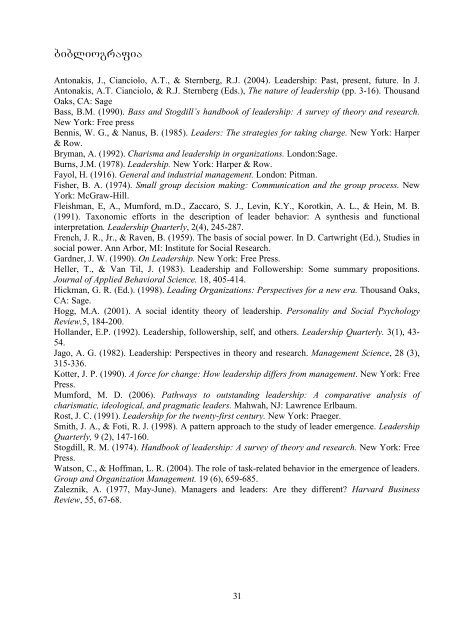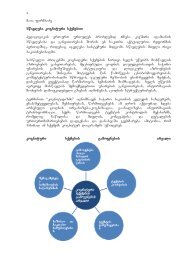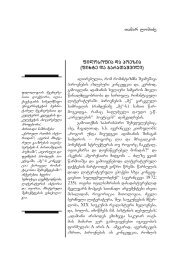- Page 2 and 3: lideroba Teoria da praqtika mexuTe
- Page 4 and 5: 10 11 12 13 10 9 8 7 6 5 4 3 2 mTav
- Page 6 and 7: sarCevi winasityvaoba 14 aRsaniSnav
- Page 8 and 9: situaciuri magaliTi 5.2. ratom ar g
- Page 10 and 11: ogor muSaobs avTenturi liderobis Te
- Page 12 and 13: klasterebis maxasiaTeblebi 316 ingl
- Page 14 and 15: eZRvneba lorels, skots, lizas da me
- Page 16 and 17: aqvea kiTxvarebis amosabeWdad gamza
- Page 18 and 19: Tavi I Sesavali lideroba gansakuTre
- Page 20 and 21: jgufebze, romlebsac saerTo mizani a
- Page 22 and 23: Tanamdebobrivi da aRiarebuli lidero
- Page 24: cxrili adaptirebulia. wyaro: “The
- Page 28 and 29: sqema adaptirebulia Semdegi wyaroda
- Page 33 and 34: Tavi 2 lideroba, rogorc Tviseba Teo
- Page 35 and 36: 7. mzaoba miiRo interpersonaluri st
- Page 37 and 38: inteleqti inteleqti an inteleqtualu
- Page 39 and 40: eqstravertuloba - socialurobisa da
- Page 41 and 42: Secvalon saqmianoba imisaTvis, rom
- Page 43 and 44: praqtikaSi gamoyeneba uaryofiTi mxa
- Page 45 and 46: enis kompania erT-erTi gaxldaT im s
- Page 47 and 48: 2. rogor fiqrobT, ramdenad SesaZleb
- Page 49 and 50: gmrZnobiaroba 4 4 5 5 5 4.6 empaTiu
- Page 51 and 52: Mann, R. D. (1959). A review of the
- Page 53 and 54: amocanebs. am TavSi naCvenebia, rom
- Page 55 and 56: erTanirad mniSvnelovania marTvis ro
- Page 57 and 58: adaptirebulia Semdegi wyarodan: “
- Page 59 and 60: organizaciaSi sxvaTa xedvis gaTvali
- Page 61 and 62: motivacia. motivacia modelis mesame
- Page 63 and 64: adaptirebulia Semdegi wyarodan: “
- Page 65 and 66: pirdapir an arapirdapir, gansakuTre
- Page 67 and 68: yvela safexurze myofma liderma SeiZ
- Page 69 and 70: inJineriis magistris xarisxic moipo
- Page 71 and 72: 3. adamsi rom gagewvrTnaT liderobaS
- Page 73 and 74: unar-Cvevebis kiTxvari instruqcia:
- Page 75 and 76: pirovnuli maxasiaTeblebi. liderebis
- Page 77 and 78: Tavi 4 lideroba, rogorc stili lider
- Page 79 and 80: miCiganis universitetis kvlevaSi or
- Page 81 and 82:
wyaro: Leadership Grid figure, Pate
- Page 83 and 84:
sqema 4.2 paternalizmi/maternalizmi
- Page 85 and 86:
qvemoT moyvanili magaliTi dagvexmar
- Page 87 and 88:
erT-erTi aseTi saganmanaTleblo prog
- Page 89 and 90:
keTebaa. igi iSviaTad, an saerTod a
- Page 91 and 92:
2. jgufis wevrebTan megobrul damoki
- Page 93 and 94:
adamianebze da zrunva Sedegebze. im
- Page 95 and 96:
Tavi 5 liderobis situaciuri midgoma
- Page 97 and 98:
direqtiul (saqmis davalebaze orient
- Page 99 and 100:
pasuxismgebloba axasiaTebT. maT aqv
- Page 101 and 102:
da bolos, situaciuri lideroba Segva
- Page 103 and 104:
struqturirebul samuSao garemos arCe
- Page 105 and 106:
ikma, bolo kvirebis manZilze, Tavis
- Page 107 and 108:
kiTxvebi 1. SLII modelis mixedviT (
- Page 109 and 110:
situaciuri lideroba instruqciebi: g
- Page 111 and 112:
mokle kiTxvaris pirveli situacia aR
- Page 113 and 114:
ganviTarebis maRal dones. aseve gau
- Page 115 and 116:
Tavdajerebulobis xarisxi, erTguleba
- Page 117 and 118:
wevrebis cudi urTierTobebiT gamoirC
- Page 119 and 120:
SeiZleba es bevr adamians araadekva
- Page 121 and 122:
2. mis LPC qulas Tu gaviTvaliswineb
- Page 123 and 124:
yvelaze naklebad sasurveli TanamSro
- Page 125 and 126:
ibliografia Fiedler, F. E. (1964).
- Page 127 and 128:
mokled rom vTqvaT, miznis miRwevis
- Page 129 and 130:
miRwevaze orientirebuli lideroba mi
- Page 131 and 132:
daexmaros maT daZlevaSi. aseT SemTx
- Page 133 and 134:
gavlenaze TanamSromlebis muSaobis S
- Page 135 and 136:
Teoria SesaZloa gamoyenebuli iqnas
- Page 137 and 138:
eqspertis saukeTeso nazavi. xelmZRv
- Page 139 and 140:
erbinaT treningze, ra unda eWamaT,
- Page 141 and 142:
8. vigoneb patara siurprizebs, raTa
- Page 143 and 144:
arian, xolo miRwevaze orientirebuli
- Page 145 and 146:
Tavi 8 liderisa da jgufis wevris ur
- Page 147 and 148:
SeniSvna: lideri (l) qmnis individu
- Page 149 and 150:
gansxvavebebze, Semdgomi kvlevebi m
- Page 151 and 152:
TanamSromlebisTvis axali gamowveveb
- Page 153 and 154:
imis miuxedavad, aRweriTia Tu instr
- Page 155 and 156:
ogor zemoqmedeben samarTlianobis es
- Page 157 and 158:
eTmoba zogierTi TanamSromels sxvebz
- Page 159 and 160:
siti mortgeijSi Zalian pozitiuri at
- Page 161 and 162:
miuxedavad imisa, rom sarCelebze mo
- Page 163 and 164:
aranairi mcire saSualo maRali Zalia
- Page 165 and 166:
LMX Teorias ramdenime mniSvnelovani
- Page 167 and 168:
Tavi 9 transformaciuli lideroba aRw
- Page 169 and 170:
qarizmatulma liderobam didi yuradRe
- Page 171 and 172:
Bass-is mixedviT, transformaciuli l
- Page 173 and 174:
wyaro: Bass, B. M., & Avolio, B. J.
- Page 175 and 176:
daptirebulia Semdegi wyarodan: “T
- Page 177 and 178:
aqvs sawarmos ganviTarebis grZelvad
- Page 179 and 180:
gamxneveba. liderebi ajildoeben ada
- Page 181 and 182:
mexuTe _ transformaciuli lideroba g
- Page 183 and 184:
destruqciuli miznebisTvis iqnas gam
- Page 185 and 186:
TanamSromlebs xels uSlida sawarmos
- Page 187 and 188:
3. ra xedva gaaCnia profesor kuks a
- Page 189 and 190:
im kvlevebis analizis Sedegad, roml
- Page 191 and 192:
ibliografia 191
- Page 193 and 194:
193
- Page 195 and 196:
gansazRvreba unikaluria da avTentur
- Page 197 and 198:
midgomas zneobrivi winapiroba udevs
- Page 199 and 200:
orblis gamoyenebiT, liders SeeZlo g
- Page 201 and 202:
George-is mixedviT, dRes adamianebs
- Page 203 and 204:
xels uwyobs pozitiur TviT-ganviTare
- Page 205 and 206:
sqema 10.2 pozitiuri fsiqologiuri S
- Page 207 and 208:
avTenturi lideroba kompleqsuri proc
- Page 209 and 210:
gamoyeneba vinaidan avTenturi lider
- Page 211 and 212:
dawerila, yvelgan aqcenti imaze keT
- Page 213 and 214:
SemTxvevaSi soflis awiokebiT daimuq
- Page 215 and 216:
situacia 10.3 pirveli ledi survilis
- Page 217 and 218:
omelTa Soris saSualo klasis dedebi,
- Page 219 and 220:
2. SekribeT Semdegi debulebebis pas
- Page 221 and 222:
ibliografia 221
- Page 223 and 224:
Tavi 11 gundis lideroba suzan kogle
- Page 225 and 226:
gundebs, erTi lideris mqone gundebT
- Page 227 and 228:
lideris gadawyvetilebebi • monito
- Page 229 and 230:
Sida gare jgufis xarvezebis diagnos
- Page 231 and 232:
wevrebis urTierTobebis awyobazea fo
- Page 233 and 234:
aris maTi mizani, misi intervencia
- Page 235 and 236:
mkvlevarebi sistematurad swavloben
- Page 237 and 238:
kolaboraciuli klimati. gundis efeqt
- Page 239 and 240:
aZlevs liders ukukavSiric miiRos, r
- Page 241 and 242:
CamorCeba. aseTi midgoma Sesabamiso
- Page 243 and 244:
ganxorcielebis swavlebisaTvis, raTa
- Page 245 and 246:
situacia 11.2 ganxilvebSi isini dom
- Page 247 and 248:
kvlevebis Sedegad 42 sakiTxiani kiT
- Page 249 and 250:
1-7 kiTxvebi adaptirebulia Semdegi
- Page 251 and 252:
251
- Page 253 and 254:
damokidebuleba gviyalibdeba. mamis
- Page 255 and 256:
erT-erTSi SeiZleba imyofebodes. kon
- Page 257 and 258:
sqema 12.1. egogramis magaliTi ____
- Page 259 and 260:
mdgomareobaSi myofi adamianis urTie
- Page 261 and 262:
akmayofileben iseTi adamianebis moT
- Page 263 and 264:
moqmedi individebi gacilebiT advila
- Page 265 and 266:
xSirad eqstravertul samyarosTan ada
- Page 267 and 268:
meore adgilze gavida "gansjis moyva
- Page 269 and 270:
INFJ SemoqmedebiToba gamomgonebeli,
- Page 271 and 272:
gansxvavebulobis gacnobiereba da ga
- Page 273 and 274:
samsaxurSi wamoWril emociur situaci
- Page 275 and 276:
3. unda miuZRvnas Tu ara stemma erT
- Page 277 and 278:
TiToeuli debulebisTvis Tqvens mier
- Page 279 and 280:
279
- Page 281 and 282:
gavrcelebuli dasabuTebebi. da bolos
- Page 283 and 284:
(amerikis samuSao Zalis statistikis
- Page 285 and 286:
adamianuri kapitalis aseTi savaraud
- Page 287 and 288:
qalebs ufro meti barierebi xvdebaT
- Page 289 and 290:
om dasWirveboda, posteris ,,gamiuTa
- Page 291 and 292:
ewinaaRmdegebian da mis absoluturad
- Page 293 and 294:
arsebobs mtkicebulebebi, rom bolo d
- Page 295 and 296:
iwvevs sirTuleebs liderobis ierarqi
- Page 297 and 298:
etyvi Cvens klientebs? Cveni firmis
- Page 299 and 300:
liderobis Sesafasebeli instrumenti
- Page 301 and 302:
qulebis miniWeba IAT testis logika
- Page 303 and 304:
ibliografia 303
- Page 305 and 306:
305
- Page 307 and 308:
307
- Page 309 and 310:
309
- Page 311 and 312:
umTavresi cnebis aRweriT viwyebT. S
- Page 313 and 314:
arseboba. xandaxan, crurwmena Cvens
- Page 315 and 316:
jgufis koleqtivizmi es ganzomileba
- Page 317 and 318:
adaptirebuliaESemdegi wyarodan: HHo
- Page 319 and 320:
aRmosavleT evropa am klasters mieku
- Page 321 and 322:
lideruli qceva da kulturis klastere
- Page 323 and 324:
qarizmatulia, magram garkveulwilad
- Page 325 and 326:
CrdiloeT evropis liderobis maxasiaT
- Page 327 and 328:
adaptirebulia Semdegi wyarodan - Ho
- Page 329 and 330:
axlo aRmosavleTis liderobis maxasia
- Page 331 and 332:
Zlieri mxareebi miuxedavad imisa, r
- Page 333 and 334:
liderobis maxasiaTeblebad iyo dafiq
- Page 335 and 336:
samira sakuTar TavSi pasuxismgeblia
- Page 337 and 338:
anki Zalian amayobs imiT, rom qveya
- Page 339 and 340:
ar efuZneboda centris Cveul samuSao
- Page 341 and 342:
1. am sazogadoebaSi biWebs, gogoebT
- Page 343 and 344:
jgufis koleqtivizmi genderuli egali
- Page 345 and 346:
2. GLOBE-is mkvlevarebi (mesame faz
- Page 347 and 348:
Tavi 15 liderobis eTika aRwera es T
- Page 349 and 350:
marTebuli, an araswori” imaze dak
- Page 351 and 352:
ganicdis. aretaic berZnuli terminia
- Page 353 and 354:
Burns-is Sexeduleba eTikur lideroba
- Page 355 and 356:
liderobis sferos mecnierTa mier war
- Page 357 and 358:
pasuxismgeblobebis ganawileba, gund
- Page 359 and 360:
socialuri wvlilis mixedviT; damsax
- Page 361 and 362:
xolo miznebi iseTi hqonda, romlebsa
- Page 363 and 364:
liderebs SeuZliaT am kvlevebSi moce
- Page 365 and 366:
aqvs da im sadazRvevo kompanias, ro
- Page 367 and 368:
gakeTeba unda ecada am kompanias? r
- Page 369 and 370:
19. TvalTmaqcia 1 2 3 4 20. Surisma
- Page 371 and 372:
eTikasa da liderobaze Catarebul kvl
- Page 373 and 374:
373
- Page 375:
375






